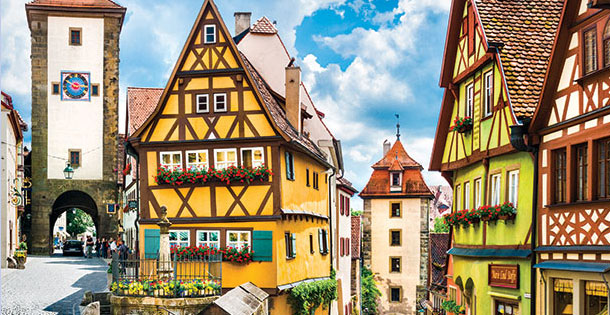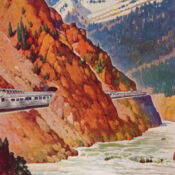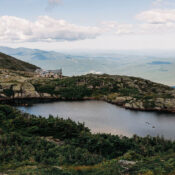Where to stay, where to eat, and what to see in one of the most scenic regions of Germany: The Romantic Road stretches a little over 200 miles from Würzburg to Füssen. Starting from the north and ending at Neuschwanstein Castle and views of the alps is the popular route. For that very reason, this North-to-South path can get congested on the two lane road.
To avoid traffic, we suggest touring in the opposite direction, starting in Füssen.
Fly to …
MUNICH
And spend a night at Louis Hotel to overcome jet lag. While there, enjoy the rooftop terrace (and restaurant) that overlooks the famous 1807 Viktualienmarkt. Then, rent your vehicle of choice and begin your adventure! (Click here to read the travel essay “Bavaria for Lovers” from the January/February 2015 issue.)
FÜSSEN
Where to Stay
- Hotel Hirsch
Run by the same family for four generations, this art nouveau-style hotel located on the edge of Füssen’s old town combines modern comfort with comfy Bavarian ambience. The roof garden offers a panoramic view of Füssen’s picturesque old town. - Hotel Fantasia
Budget-friendly art nouveau villa situated right in the heart of town is minutes from the shuttle to the castles, train, and taxi station. Expansive garden offers perfect views of the Alps and High Castle. - Luitpoldpark-Hotel
Just a few minutes’ walk from the old town, this hotel features good food and an Ayurveda and beauty studio.
Where to Eat
- Altstadthotel Zum Hechten
Regional organic specialties from local recipes of the alpine region, such as breaded pork schnitzel and Swabian roast with crispy onions. - Herzl am Rathaus
Classic Bavarian delicacies, tap beer, and country breads. Don’t miss the Flammkuchen (similar to pizza). - Hotel Schlosskrone Coffee House and Pastry Shop Kurcafé
100-year-old coffeehouse, located in the Hotel Schlosskrone old town. Famous for “Sissi-Torte,” cakes, gateaux, and truffles. Try the luncheon all-you-can-eat buffet.
Don’t Miss
- Medieval Old Town
Füssen’s medieval town center is ideal for strolling, shopping and exploring the winding streets with Gothic gabled roofs, the remains of the old city walls, and Baroque churches. - The Füssen Heritage Museum (Museum der Stadt Füssen)
Located in the former Benedictine Monastery of St. Mang, this museum has one of the finest European collections of historical lutes and violins. - Neuschwanstein Castle
Near Füssen, in Schwangau, this fairy-tale castle was built from 1869 to 1886 by King Ludwig II, is said to be the model for Disney’s Sleeping Beauty castle. Best to book tickets in advance. - Hohenschwangau Castle
Opposite Neuschwanstein Castle, King Ludwig II’s father built this castle as a summer residence for the royal family. Book ahead and online. - Boat trips on Lake Forggensee
For the best panoramic views of Neuschwanstein and Hohenschwangau castles, take a cruise around Lake Forggensee.
Worth a Half-Day Visit: Nördlingen
Located in the center of a gigantic meteorite crater, this is the only town in Germany where visitors can walk completely around its walls and battlements. The late Gothic church St. George has a 295-foot tall bell tower which visitors are welcome to climb.
Worth a Half-Day Visit: Dinkelsbühl
Dating back over 400 years, this picturesque town with its patrician and enchanting semi- timbered houses and magnificent churches make it one of Germany’s best-preserved medieval towns.
ROTHENBURG OB DER TAUBER
The walled town of Rothenburg ob der Tauber is straight out of the late Middle Ages and is one of the most stunning towns on the Romantic Road. Brightly painted half-timbered houses with tall gable roofs line every cobblestone alleyway and square.
Where to Stay
- Hotel Reichs-Küchenmeister
Family-friendly hotel offers garden terrace, spa, wine tavern, and restaurant serving up Franconian and international cuisine. - Hotel Goldener Hirsch
Many rooms offer spectacular views over the Tauber Valley. Centrally located, making it an ideal place from which to explore Rothenburg. - Bell Winery and Hotel (Glocke Weingut und Hotel)
Cozy comfortable rooms and a Franconian pub-restaurant, serving home-style cuisine, (don’t miss the fish). Nice regional wine selection.
Don’t Miss
- St. Jacob’s Church
Famous for its altars, particularly the famous Heilig-Blut-Altar (Holy Blood Altar) by Tilman Riemenschneider. - Medieval Crime Museum (Kriminalmuseum)
Kids will enjoy the instruments of torture. - German Christmas Museum (Weinachtmuseum)
Store features new and antique Christmas decorations. Wide range of wood and glass ornaments, music boxes, nutcrackers, wintry and heavenly scenes, and more. - Night Watchman Tour
Actors, dressed as a medieval night watchmen, lead guided tours (in English) at 8 p.m. every night, March through Christmas, in Market Square. Your watchman will also point out the city’s best bars, including one called Zur Holl (To Hell).
Worth a Half-Day Visit: Wieskirche Church, Steingaden
The famous rococo “Church of the Scourged Saviour” or Wieskirche church was built in the mid 18th century and is a UNESCO World Heritage Site. Time your visit to a Sunday morning when the men’s choir sings.
AUGSBURG
Founded by Roman Emperor Augustus more than 2,000 years ago, this is one of Germany’s oldest cities. It’s economic highpoint came in the 15th and 16th centuries under the trading and banking activities of the Fugger and Welser families.
Where to Stay
- Steigenberger Drei Mohren
500-year-old hotel, one of the most traditional in Bavaria. Located near Schaezlerpalais, a magnificent baroque palace housing numerous art collections). - Hotel am Rathaus
Combing modern comfort with the best of Augsburg’s historic charm, this hotel is located near majestic town hall and other attractions, restaurants, and bars and cafés. - Dorint Hotel — An der Kongresshalle
Based on Chicago’s Marina Towers, very sleek, equipped with the most modern amenities
Where to Eat
- Zeughausstuben
Popular with tourists and locals alike. Choose between traditional Bavarian and Swabian cuisine. Speatzle, anyone? - Prinz-Karl Restaurant
Located in a renovated 19th century historic barracks complete with historic cross vaults and cozy fireplace. In summer, head for the beer garden. - Die Ecke
One of the town’s finest. In olden times, Die Ecke hosted kings and their entourages.
Don’t Miss
- The Fuggerei and the Fugger City Palace
Founded in 1521, this is the world’s oldest social housing: 67 houses and 140 council flats. The annual rent is 1 Rhenish gulden (the equivalent of $1.31). The attractive inner Ladies’ Court was built in the style of the Italian Renaissance. - Augsburg Puppenkiste (Puppet Theater)
Displays much-loved marionettes and the history of the theater. - City Hall and Perlach Tower
Built by Elias Holl from 1615 – 1620, this City Hall is one of the most significant secular Renaissance building north of the Alps. Featuring: magnificent portals, a coffered ceiling, and mural paintings everywhere.
Worth a Half-Day Visit: Bad Mergentheim
Known as a health and spa vacation city, this Romantic Road city has an entire wellness park, flowering spa gardens, and an authentic Castle of the Teutonic Order, which includes a church and museum.
WÜRZBURG
Set in the heart of the Franconian wine region on the River Main, this city is dominated by the Marienberg Fortress and surrounded by vineyards. The Residential Palace is a UNESCO World Heritage Monument and there is also a magnificent Cathedral, Chapel of St. Mary and romantic Old Bridge over the River Main (complete with a bar in the center of the bridge).
Where to Stay
- Best Western Premier Hotel Rebstock
Behind a striking Rococo façade are 70 stylish newly refurbished rooms. Home to “Kuno 1408” where Michelin-starred chef Benedikt Faust serves up inventive cuisine based on regional produce. - Ghotel Hotel & Living Würzburg
Würzburg’s tallest building, a striking 17-story high-rise, houses Würzburg’s newest hotel. The higher floors have breathtaking views. - Mercure Hotel Würzburg am Mainufer
Part of the Accor brand, the Mercure is just a five-minute walk to the Old Town.
Where to Eat
- Würzburger Ratskeller
Hearty and moderately priced dishes in the Franconian tradition. In warm weather, choose the shady inner courtyard. - Brauerei-Gasthof Alter Kranen
Classic German dishes as well as (surprise!) some good vegetarian options. Dine in the beer garden and try the regi. - Restaurant Alte Mainmühle
Tables at this former mill located next to Würzburg’s Old Bridge offer spectacular views of the river Main and the Marienberg Fortress. Don’t miss famous specialty, the “Franconian Wedding Dish” (tender boiled beef with noodles, horseradish sauce and cranberries).
Don’t Miss
- Residenz
The Residence Palace, built by Balthasar Neumann, Europe’s greatest Baroque era architect in 1720, is the city’s prime attraction, one of the most beautiful castles in Germany. Tiepolo designed the grand staircase with the world’s largest ceiling fresco. - Röntgen Memorial Hall
In 1895, Würzburg University physicist Wilhelm Conrad Röntgen discovered the X-ray. Admire his laboratory and some of the original lab equipment at Röntgen Memorial Hall. (Free admission.)
Don’t Miss
This award winning museum showcases an outstanding collection of post-1945 European Concrete Art as well as an historical granary and Impressionist and Expressionist artworks.
For more information on Bavaria, visit bavaria.us
Become a Saturday Evening Post member and enjoy unlimited access. Subscribe now



